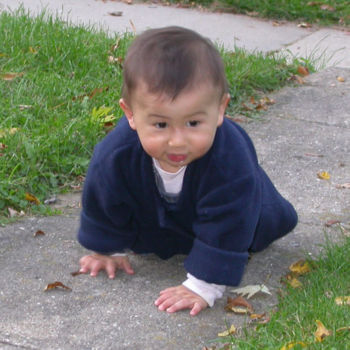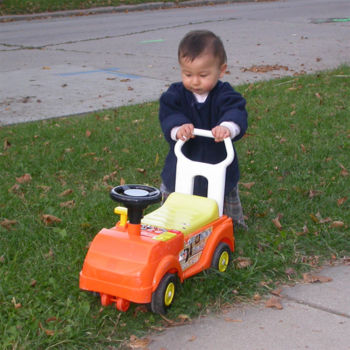Infant growth and development
Growth and development are the main themes of a baby's life. It is through these processes that that a newborn ends up becoming a toddler -and then a child, and it is continued growth and development in childhood and through puberty that usher the childl into adulthood. There are two stages in human life when growth and development are most rapid and profound, one is in infancy and early childhood, and the other is during puberty and adolescence. Although there are short periods during any stage when a child or adolescent is mainly just getting bigger; infancy, childhood and adolescence are not focused on a mere increase in size, but on changes in shapes, qualities and abilites. There is no one term in English that encompasses that concept, and in life sciences, "growth and development" has become the phrase that is conventionally used to describe the changes of the body (and mind) that occur from birth to maturity. This article examines the early portion growth and development in human life, covering the normal progress of a newborn up to the time of walking, about the first year to 18 months of life. The next stage of life is discussed in Toddler growth and development, which will cover the normal child from walking to the socialization of the preschool era, from about age 1 year to age 4 years.
Oddly enough, there is an inherent connection between the very immature state of the newborn brain, an important feature at the starting point of infancy; and the very human act of walking upright, the end point of our discussion here, that marks the beginning of a child's "toddler stage". Human beings, as a species, have a large brain that is capable of a high intelligence, and an upright body position that is propelled by walking on two legs. Walking upright allows for less leeway in size and structure in the human pelvis than exists for those animals that walk on all fours. That means that big-headed babies are born to mothers with relatively constrained birth canals, and if both mother and baby are to survive the birth process unscathed, that means the baby's brain cannot be fully developed in size; or complexity; at birth. No matter how precocious we may fancy that our children are, no human baby is precocious in the same sense as a horse's newborn foal or a duckling just out of the egg- unlike these new babies, that can run and swim, humans are unable to do much more than feed and interact with their caregivers until several months of life have passed.
Our newborns have a skull that contains a brain case only one quarter the size that it will become in the adult. Much of the growth of the brain; and the concommittent expansion of the head; has occurred by the age of 2 years; at that age the neurocranium (which means the bony skull that surrounds the brain) is 75% of the adult size by volume, and the brain is about 80% of its adult weight. By about 10 years of age, the brain (and skull) are aproximately 95% their ultimate size. Overall, the human brain more than triples in size (3.5 X) from birth to adulthood.
Even with the relatively small head diameter of the newborn, that skull has some adaptations that allow it to be molded in the birth canal, so that the diameter can become even smaller, allowing the baby to emerge without harm to itself or to its mother. These same adaptations give the baby's skull the ability to expand to accomodate the growing brain - they are the suture lines and fontanelles of the infant skull.
When babies are brought to the pediatrician or other health care provider for well-child care, the infant's length, weight, and head circumference are routinely measured. The "soft spots" of the skull, the fontanelles. are gently touched and assured to be either properly open or closing, and not unduly tense. The baby is also checked for reflexes and activities that are the signs of normal physical and mental progress. Although the rate of change is a bit different for each individual child, the changes follow a set of curves that are so similar for all children that deviations from the expected values are signs that trouble may be afoot. Since youngsters are so adaptable, and so many problems are now amenable to treatment with early intervention and proper medical care, many things that would have once proved devastating to the baby's future can be averted or minimized with careful monitoring of our infants progress and judicious evaluation of possible abnormalities.
This article reviews the important milestones, and their timing, that unfold during an infant's life. Strictly, the term "infant" only applies to baby during the first year, but since such activities as walking can normally occur either during the first year or after, a broader range of ages is considered here.
Newborns
A newborn baby has
Normal full term newborn infants
Premature newborns
The concept of "gestational age"
"Small for gestational age" newborns
"Large for gestational age" newborns
Physical size and growth
Height (length), weight (body mass), and head circumference
The face
Teeth, ears and sinuses
Neurologic development
Milestones
smiling
rolling over
sitting up
grasp (thumb and fingers)
crawling
standing up
walking
Changes in the body that come from activities
Body parts are not static structures, they change depending on how they are used. Weight bearing and mechanical forces thicken bone, and so muscles and bone change together as they grow. For example, the mastoid process, which is the thick bump that can be felt behind any adult's ear (down around the region of the upper earlobe), does not exist in the newborn baby, instead the baby's skull is flat behind the ear. A muscle in the neck, the sternocleidomastoid muscle, runs, in part, from this spot on the skull, down to the collar bone and the top of the sternum. As the muscle contracts with the greater force as the baby grows and develops the ability to raise his head and hold it up, the bone actually thickens and the mastoid process developes. Other changes in the body occur with standing and walking. The spine developes what is called "lordosis", the straight backed baby has a different back contour than the walking toddler. The bottom of the feet in the baby who does not stand are "rocker-bottom" shape, and change as the child puts weight on those feet and change still more with walking. In those disabled children who never walk , the feet retain their infant contour.

